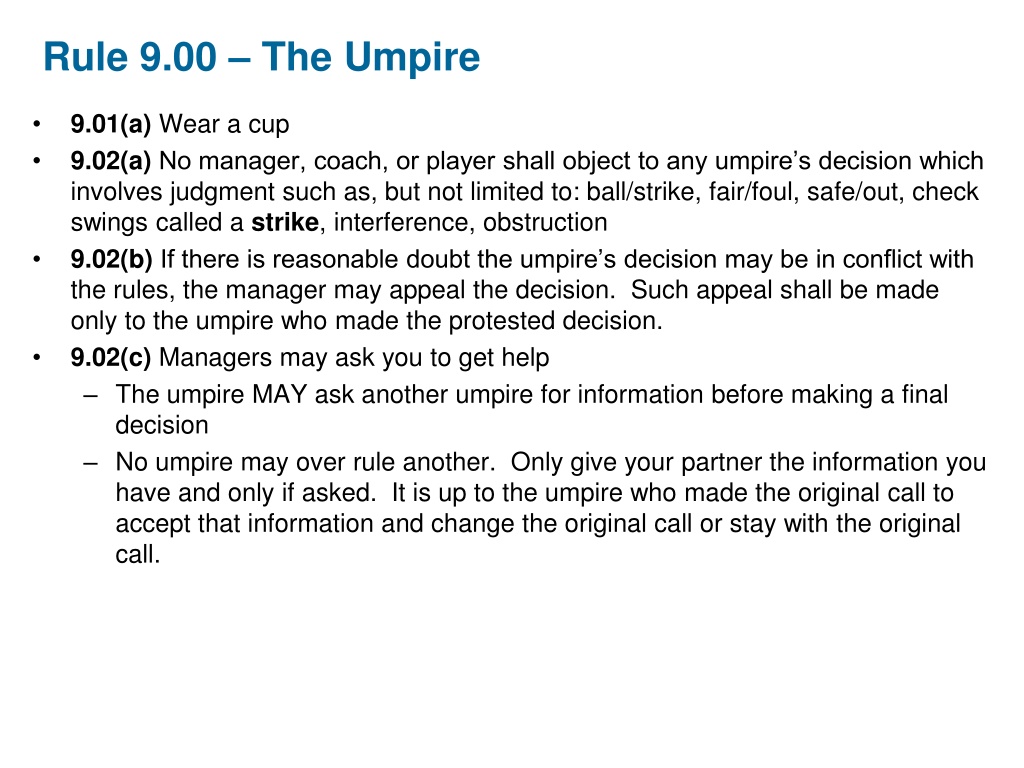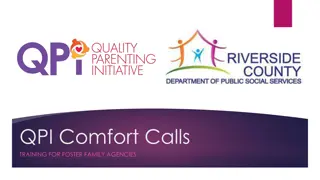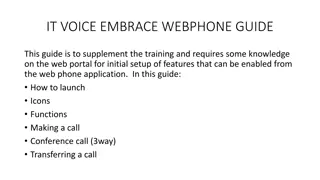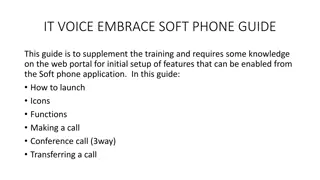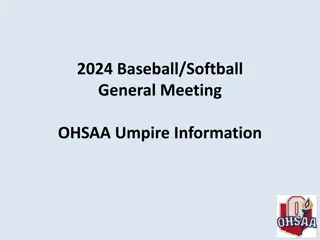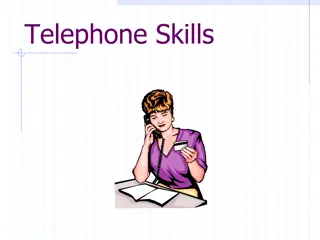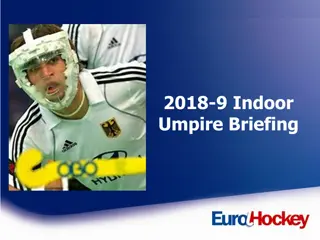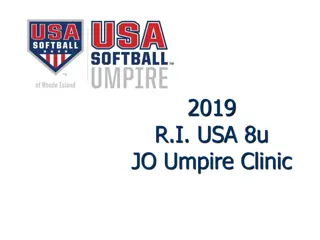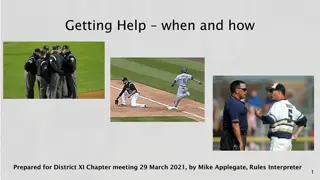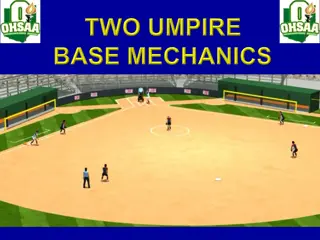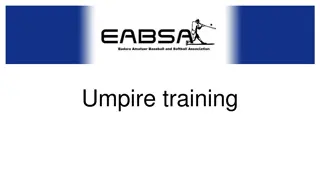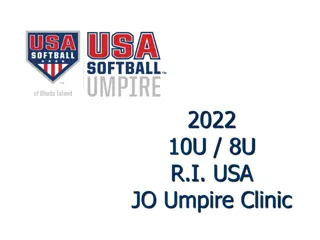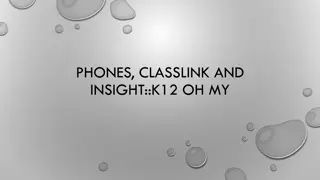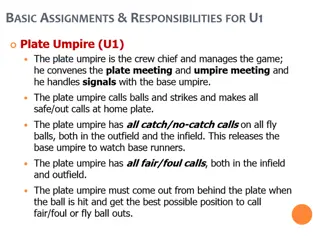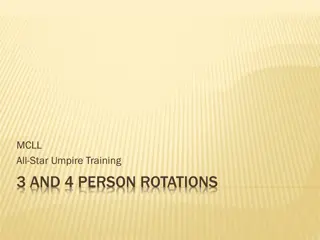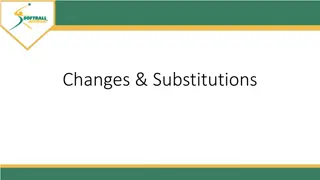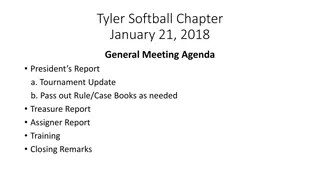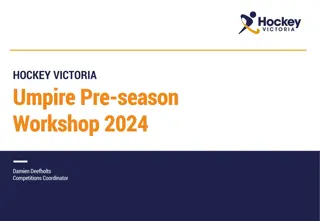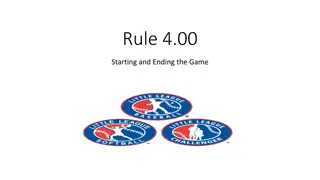Umpire Guidelines and Best Practices for Making Calls
Umpires need to follow specific rules and guidelines, including wearing protective gear and handling objections from managers and players. Establishing eye contact, staying calm, pausing before making a call, and seeking assistance from a partner are essential practices to ensure accurate and confident officiating on the field.
Download Presentation

Please find below an Image/Link to download the presentation.
The content on the website is provided AS IS for your information and personal use only. It may not be sold, licensed, or shared on other websites without obtaining consent from the author. Download presentation by click this link. If you encounter any issues during the download, it is possible that the publisher has removed the file from their server.
E N D
Presentation Transcript
Rule 9.00 The Umpire 9.01(a) Wear a cup 9.02(a) No manager, coach, or player shall object to any umpire s decision which involves judgment such as, but not limited to: ball/strike, fair/foul, safe/out, check swings called a strike, interference, obstruction 9.02(b) If there is reasonable doubt the umpire s decision may be in conflict with the rules, the manager may appeal the decision. Such appeal shall be made only to the umpire who made the protested decision. 9.02(c) Managers may ask you to get help The umpire MAY ask another umpire for information before making a final decision No umpire may over rule another. Only give your partner the information you have and only if asked. It is up to the umpire who made the original call to accept that information and change the original call or stay with the original call.
Umpire Rules Establish eye contact with your partner before every pitch. Stay on the same page (i.e. balls, strikes, outs, infield fly, etc.) Never criticize your partner on the field. Discuss plays or calls you saw differently or when you believe a rule had been improperly applied between innings. Any serious differences should be discussed in private after the game. Remember only an umpire can call time . Managers and players request time Keep the game moving!
Pause before making the call Problem Umpires sometimes feel pressure to make quick calls (nerves, knowing everyone is watching you, the fast pace of a play) In a fast action play, a new umpire will sometimes make a split second decision and make a quick call Quick calls are many times wrong Examples: Close play at first. What did you really see? Did runner s foot hit the bag first, or was the ball caught first? Are you absolutely sure of your call? Are you sure first baseman didn t pull his foot? Runner stealing 2ndwith a close tag. After your quick out call, you notice the ball on the ground between the runner and the fielder
Pause before making the call (contd) Solution Stay calm at all times before, during and after a play Feeling out of control will sometimes cause a knee-jerk fast call Watch the play through to completion And think about what you just saw Force yourself to delay (maybe by counting to 2) before verbalizing your call Think to yourself I m sure he was safe/out then say it for real, and appear confident as you make the call On tag plays, find where the ball is after the play is over and confirm the out only after verifying that the fielder had the ball in the tag-hand and had never lost control of it during the play if the fielder is picking it up off the ground, runner was likely safe if you think the tag was good but you aren t sure where the ball is, ask the fielder to show you the ball, then make the call as needed
Coach Appeals vs. Judgment Calls Coaches can only appeal a call when they deem a rule was violated or not applied correctly Coaches cannot appeal or argue judgment calls Six common judgment calls Ball or Strike Fair or Foul Safe or Out (very common for a coach to argue safe or out) Other judgment calls Whether obstruction or interference has occurred Whether a hit ball is an Infield Fly Check swing calls called a strike
Handling appeals and arguments Coach disagrees with call Must request time from the dugout Umpire may grant time but should do so only after the play has stopped Common reaction is to grant time right away. Don t. Hold up your hand to acknowledge the request but wait until play is over Coach must approach the umpire who made the call Coach can ask for a clarification of the call Tips for Umpire Realize this situation is common, so get used to it Be confident in yourself, but not arrogant or argumentative Be respectful You might have been wrong, so don t set yourself up to eat crow . This will earn their respect for that game and those that follow Start your response: Coach, this is what I saw Remember: Appeals are not debates
Appeals & Umpire Conferences When can (or should) one umpire help another with a call? 9.02c No umpire can over-rule or seek to reverse the decision of another umpire unless asked to do so by the other umpire Coach asks BU to seek help from PU If question deals with a judgment call, coach shouldn t be appealing, although sometimes a coach will do so anyway under the polite explanation that he thinks your view may have been obstructed. If your view was not obstructed, simply say Coach, I had a clear view and I ruled him out BU does not have to seek opinion of PU if BU is confident in the call or ruling (but if you have any doubt, go ahead and consult) During conference: Keep coaches & players away. Ruling umpire can ask for help but this is not to be interpreted as BU asking PU to make the call, nor should PU take over in an attempt to correct the situation . BU simply asks PU what did you see , or did you see him drop the ball (whatever the situation requires). Once BU is satisfied, turn and make your final call After conference: Original umpire who made the call reinforces original call or changes call (can provide brief explanation such as Foot was off the bag runner is safe at first )
No Rabbit Ears Umpires are expected to have thick skin Expect complaints and criticism it s natural for fans to think you made a bad call when it didn t go their way Learn to brush it off (almost as though you didn t hear it tune out the fan chatter ) For the common complaints and comments don t react to fan criticism Reacting acknowledges that you heard the comment and will encourage repeat behavior Many times a complaining fan will stop complaining if it doesn t get them anywhere (they make a spectacle of themselves) NEVER react by engaging spectators in arguments or debates about behavior or a call
Handling Difficult Fans Out-of-Control Fans Little League rule 9.01(f) explains how to handle unruly spectators Don ts Don t engage spectators in arguments or debates Don t eject a manager as a way to punish a team whose fans are complaining or out of control, or in an attempt to regain control Official rules do not provide this course of action and do not imply that it is the coach s responsibility to control the spectators Do s Call time and contact a league official (board member) to gain control If required, clear the field until control is regained If control is not regained, consider postponing conclusion of game until a later date.
Ejections Can only eject people from the playing field, not the bleachers Players, Managers, Coaches, Press Box Reasonable reasons for ejections Players Threats, either verbally or via body language Cursing Repeated complaints about calls (again, try to have a thick skin) Reserve ejections to those who really deserve it. But don t permit anyone to continually demonstrate disrespect to either the umpire crew or anyone else involved in the game Gross unsportsmanlike behavior Flagrant malicious contact Example: Plowing over the catcher while attempting to score Reasonable reasons for ejections Managers/Coaches Same as for players Encouraging or egging-on spectators to complain about umpires calls Arguing a call and not giving up on it
Base Umpire Positions Minors and Majors C B D A 10-12 behind 1st baseman 60 Diamond Note: The D position is only used when there are more than 2 base umpires (i.e., 3 and 4 umpire crews). It won t likely be used in regular season games since most games will use 2-umpire crews
BU Position at Start of Play 60 Diamond C B B C BU BU BU BU R BU BU A A R Bases empty Any other combination (2nd only, 2nd and 3rd, 1st and 3rd, 3rd only, bases loaded) Runner on 1st
Where to go when ball is hit Ball is in You re out; Ball is out You re in If a hit ball stays in the infield BU stays outside and makes call from shallow outfield or in the dirt If a hit ball gets through to the outfield (either on a fly ball or ground ball), BU busts inside, turns to watch runner tag first and follows runner and ball to the play. BU should be set ahead of arriving runner Example: Outfield hit with no one on BU breaks into infield, turns left to watch runner touch 1st, then moves with and ahead of runner to be ready for a play at 2nd or 3rd Only way to keep up with the runners and be in position for the play Helps you stay out of the way of the ball coming in Aside from being the proper mechanic, it makes your life as the BU much easier! BU Batter If you learn ONE thing at this clinic, learn this tip!
BU responsibilities on the pitch 1. 2. 3. 4. 5. Watching for the illegal pitch Assisting on the check swing appeal Handling the "runner leaving early" rules Watching for pickoff plays from the catcher Watching for attempted steals on passed balls and wild pitches
Who makes the call Plate Umpire Typical Calls Catch/no-catch on all fly balls and line drives whether infield or outfield All fair foul (unless discussed otherwise in plate meeting) Calls at home plate Illegal pitch Infield fly Sometimes calls at 3rd base for 1st to 3rd situations Base Umpire Typical Calls Safe out on all bases (except for 1st to 3rd situations) Obstruction or Interference Runner leaving early Illegal Pitch Infield fly
General Instructions Do not come running with your arm(s) up or down, denoting out or safe. Wait until the play is completed before making any arm motion If sure you got the play correctly, do not be stampeded by players or coaches appeals to ask the other man If not sure, ask your partner. Do not carry this to extremes, be alert and get your own plays. But remember! The first requisite is to get decisions correctly. If in doubt don t hesitate to consult your partner. Umpire dignity is important but never as important as getting the call right NEVER try to make-up for a missed call or one you think you got wrong Most important rule for umpires is always BE IN POSITION TO SEE EVERY PLAY. Even though your decision may be 100% right, coaches and players still question it if they feel you were not in a spot to see the play clearly and definitively Finally, be courteous, impartial and firm, so you are able to compel respect from all
The Base Umpire Duties shall be to: Always face the batter when the pitcher is on the mound with the ball Watch for the illegal pitch Be prepared to respond to the plate umpire on a checked swing appeal. PU: Did he go? If no swing, signal safe and call out loudly, No, he didn t or if a swing, signal strike and call out loudly, Yes, he did Handle the runner leaving early rules Watch for attempted steals on passed balls or wild pitches From position B or C make all calls at the bases unless called off by the plate umpire for a call at 3rd base or a pick-off play from the catcher to retire a runner at 1st or 3rd Always know where the ball is and let the ball take you to the play. Make all safe/out and other calls (i.e. interference/obstruction) on the bases unless you have gone out on a trouble fly ball (from A only) or your partner has called you off any play at 3rd Signal your ball/strike count with your fingers in front of your chest. Balls with your left hand and strikes with your right hand. Outs down below the waist with one or both hands. Make sure you get the count right with your partner Signal your partner when an infield fly situation exists. Wipe it off when the infield fly condition has ended Assist your partner at 3rd with any run down play between 3rd and Home, but be ready to make a call on any other runner attempting to advance during the run down action If a trouble ball call out I m going out and make the call
The Plate Umpire Duties shall be to: Take full charge of and be responsible for the proper conduct of the game Call and count balls and strikes (hold the indicator in your left hand) When giving the count, signal balls with your left hand and strikes with your right. Audible is optional except when the ball/strike count is 2 strikes and/or three balls i.e. 0/2, 1/2, 2/2, 3/0, 3/1, 3/2 Calls at home plate All fair foul (unless discussed otherwise in plate meeting) Make all fly ball calls. If your partner goes out on a trouble ball, make all calls on the infield Before the pitch, set up behind the catcher with a sight line between the catcher and the batter, placing one foot on the ground between the catcher s shoulders, 12 inches or so behind him. Your chin should be on a level approximately even with the top of the catcher s head. If the batter crowds the plate or if the catcher set up tight for an inside pitch, raise up slightly to see the plate from over the catcher s head Put the ball in play when your partner and the players on the field are ready. Point to the pitcher and audible play or play ball. Only you are authorized to make the ball live If the pitch is in the strike zone but no swing, audible strike and signal If the pitch is swung on and missed, signal strike only If the pitch is hit foul, audible foul ball and signal If the pitch is tipped back and caught, signal foul tip only unless the action was strike 3 in which case audible strike 3 and signal the out
The Plate Umpire (contd) Duties shall be to: On a checked swing called a ball, always appeal to your partner if an appeal is requested by the defensive team. No appeal is permitted if the pitch is called a strike With no runners on base or a runner at first base only and a fair ground ball is hit to the infield, follow the batter up the line 10 to 15 feet toward first base and be prepared to assist if asked by your partner on a tag or no tag, a dropped ball, or a missed base by either the runner of the defensive player With a runner or runners on base, your partner will be in position B or C; get in position to see a fly ball and the runner or runners at 2nd or 3rd who may leave too soon and tag ups With a runner on first who may try for third on the batter s hit, call out to your partner I ve got third if he comes , while moving up the 3rd base line and then into fair territory to make the call at third. If the runner attempts to score stay in fair territory and call out I m going home to make the call at home Assist your partner with any run down play between 1st and 2nd at first base and between 2nd and 3rd at third base except when a runner may attempt to score during the action Between innings the PU should remain in foul territory and move up the foul line from home plate on the side by the team taking the field. The PU counts the warm up pitches - 8 for any new pitcher and 5 for the resuming pitcher
Rule 2.00 - Definition of Terms Infield Fly 1. Fair fly ball 2. Not a line drive or bunt 3. That can be caught by an infielder with ordinary effort 4. When 1st and 2nd (or 1st, 2nd, and 3rd) are occupied 5. Less than 2 out Notes & Clarifications If a declared infield fly is allowed to fall to the ground untouched and bounces foul and remains foul before passing 1st or 3rd base, it is a foul ball. If a declared infield fly falls untouched outside the baseline and bounces fair before passing 1st or 3rd base, it is an infield fly.) Any fielder (including pitcher, catcher or outfielders) can catch an infield fly The infield dirt and outfield grass do not form a boundary line If the umpires forget to call an infield fly, the situation must be corrected. Do not allow the defense to get a double play. Make the belated call and get the situation corrected. Interference (runner, batter, catcher, umpire, coach, spectator) does not have to be intentional to be called Obstruction is the act of a fielder who, while not in possession of the ball, impedes the progress of any runner (example: blocking a base or base path while not in possession of the ball). A fake tag is considered obstruction.
Rule 7.00 The Runner 7.06 Obstruction Type (a) Type (b) Occurs when Play is being made on obstructed runner Play is not being made on obstructed runner Action Immediate dead ball Delayed dead ball Penalty Award at least one base beyond the last base touched Umpire judgment: place runner to nullify effect of the obstruction; this could be no award at all Examples (1) Catcher blocking home plate (2) Run down Batter-runner rounding 1st base Concepts to understand when determining if obstruction has occurred Fielders have a right to be where needed to field a batted ball. Therefore, even if they do not yet have possession of the ball, but are moving to or are in a position to field a batted ball, they have first right of position. The runner needs to move around or avoid the fielder in this case (otherwise they risk being called for interference). It is entirely up to the judgment of the umpire as to whether a fielder is in the act of fielding a ball After a fielder has made an attempt to field a ball and missed, he can no longer be in the act of fielding the ball. For example: an infielder dives at a ground ball and the ball passes him and he continues to lie on the ground and delays the progress of the runner 7.08(a)(1) Any runner is out when running more than three feet away from his/her baseline to avoid being tagged, unless such action is to avoid interference with a fielder fielding a batted ball. A runner s baseline is established when the tag attempt occurs and at that moment is a straight line from where the runner is to the base which he/she is attempting to reach. It is not necessarily a straight line between two bases, but can be depending on where the tag attempt first occurs.
Rule 6.07 Batting Out of Turn At Bat On Base and Before Next Pitch After Pitch If appeal is made before improper batter completes time at bat If appeal is made after improper batter completes time at bat, but before next pitch or play If appeal is made after next pitch or play Proper batter can take place in batter s box and assume count Proper batter is called out Improper batter and his/her actions are legal All base runners advances are legal Base runners advances due to actions of improper batter (i.e. hit, BB, HBP) are nullified - - other advances are legal (i.e. passed ball, wild pitch) All base runners advances are legal Next batter is one whose name follows that of the proper batter who was called out Batting order continues with batter following legalized improper batter Ex: line up of Abel, Baker, Charlie Abel singles; Charlie bats in place of Baker; Abel advance on wild pitch; defense or offense says Baker should be batting; replace Charlie with Baker; Baker assumes whatever count Charlie had, Abel remains on 2B Ex: line up of Abel, Baker, Charlie Abel singles; Charlie bats in Baker s spot and doubles; Abel to 3b; the defense appeals prior to next pitch; Baker is called out; Charlie is now the proper batter and, yes, bats again; Abel goes back to 1B (had Abel advance to 2B on a wild pitch or passed ball he would be returned to 2B) Ex: line up of Abel, Baker, Charlie Baker bats in Abel s spot and singles; Abel comes up to bat and is thrown 1 pitch; defense then realizes Baker batted out of turn. Baker s hit it legal and stays on 1B. Charlie replaces Abel and assumes the one pitch count; there is NO out; Abel is simply skipped until his next AB; IMPORTANT - the batting order does NOT change
